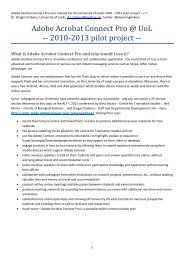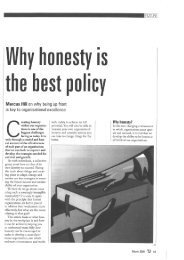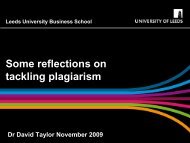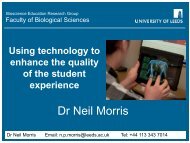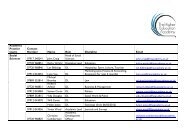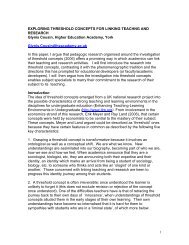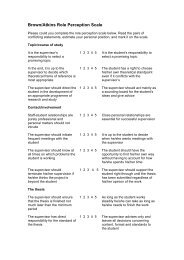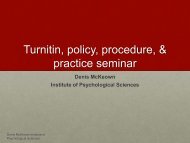Research Ethics at the University of Leeds - Staff and Departmental ...
Research Ethics at the University of Leeds - Staff and Departmental ...
Research Ethics at the University of Leeds - Staff and Departmental ...
Create successful ePaper yourself
Turn your PDF publications into a flip-book with our unique Google optimized e-Paper software.
<strong>Staff</strong> <strong>and</strong> <strong>Departmental</strong>Development Unit<strong>Research</strong> <strong>Ethics</strong> <strong>at</strong> <strong>the</strong> <strong>University</strong> <strong>of</strong><strong>Leeds</strong>Dr Alice Temple – <strong>Research</strong> <strong>Ethics</strong> SeniorTraining & Development Officer, SDDU & IDEACETL
Overview Context Ethical Review <strong>of</strong> <strong>Research</strong> <strong>at</strong> <strong>the</strong> <strong>University</strong> <strong>of</strong> <strong>Leeds</strong> D<strong>at</strong>a H<strong>and</strong>ling ContactsThemes in <strong>Ethics</strong> in <strong>Research</strong> Balancing Risks <strong>and</strong> Benefits
<strong>Research</strong> <strong>Ethics</strong>“Most people say th<strong>at</strong> it is <strong>the</strong> intellect which makes agre<strong>at</strong> scientist. They are wrong: it is character.” Einstein
Prominence <strong>of</strong> ethical issuesin researchMoral values embedded in several junctures in research: Duty <strong>of</strong> care as a researcher Legisl<strong>at</strong>ive change in human rights <strong>and</strong> d<strong>at</strong>a protection Increased public concern Awareness <strong>of</strong> responsibilities <strong>of</strong> large organis<strong>at</strong>ions Character <strong>of</strong> researchers <strong>at</strong> <strong>the</strong> forefront <strong>of</strong> progress Power <strong>of</strong> inform<strong>at</strong>ion <strong>and</strong> communic<strong>at</strong>ion technologies
Implic<strong>at</strong>ions for <strong>Research</strong>Design Many ethical <strong>and</strong> legal problems can be addressed bycareful consider<strong>at</strong>ion <strong>at</strong> <strong>the</strong> research design stage. Underlying principles <strong>of</strong> forethought, deliber<strong>at</strong>ion <strong>and</strong>critical reflection. Is “minimise risks <strong>of</strong> harm to participants <strong>and</strong>researchers’” <strong>the</strong> main concern?
Ethical Review <strong>of</strong> <strong>Research</strong> <strong>at</strong><strong>Leeds</strong>Any research <strong>at</strong> <strong>the</strong> <strong>University</strong> <strong>of</strong> <strong>Leeds</strong> involving: Human Participants including interviews, participantobserv<strong>at</strong>ion, questionnaires etc <strong>the</strong>ir d<strong>at</strong>a or tissue (excludingNHS & clinical trials etc route)<strong>Research</strong> with significant environmental impact requires <strong>University</strong> ethical review
Role <strong>of</strong> a <strong>Research</strong> <strong>Ethics</strong>Committee Supports staff <strong>and</strong> students to carry out research ethically Cross-faculty <strong>Ethics</strong> Committees – ESSL, LUBS, Env; Arts<strong>and</strong> PVAC; MAPS <strong>and</strong> Eng; BioSci; Medicine <strong>and</strong> Health Represent<strong>at</strong>ives from different research areas Active researchers http://www.leeds.ac.uk/ethics
<strong>University</strong> <strong>of</strong> <strong>Leeds</strong> EthicalReview<strong>University</strong><strong>Research</strong> <strong>Ethics</strong>Committee (UREC)ESSL,Environment &LUBS (AREA)FRECBiological SciencesFRECMedicine & HealthFRECMaPS &Engineering(MEEC) FRECPVAC & Arts(PVAR) FRECDentistry (DREC)Psychology(IPSREC)School <strong>of</strong>Healthcare(SHREC)School <strong>of</strong> Medicine(SoMREC)
Types <strong>of</strong> review Full review Light touch review Block approval (taught student modules)
PhilosophyEnsure th<strong>at</strong> researchers have considered ethical issues <strong>and</strong>have sought to minimise potential issues <strong>and</strong> plan for alleventualities.Not about stopping any particular types <strong>of</strong> research orpractices or getting in <strong>the</strong> way <strong>of</strong> research.
Applic<strong>at</strong>ion ProcessForms are available <strong>at</strong>:http://researchsupport.leeds.ac.uk/index.php/academic_staff/good_practice/ethical_review_process/university_ethical_review-1 Ensure th<strong>at</strong> <strong>the</strong> forms are fully completed <strong>and</strong> th<strong>at</strong><strong>at</strong>tachments are sent Student applic<strong>at</strong>ions must be signed <strong>of</strong>f by supervisors Usual turn around is 2-3 weeks for full review but can takeup to 6 weeks Committee may ask for fur<strong>the</strong>r inform<strong>at</strong>ion/clarific<strong>at</strong>ion
Why? Bench mark <strong>of</strong> high quality research Good practice Safety/well-being <strong>and</strong> security <strong>of</strong>Investig<strong>at</strong>ors<strong>Research</strong> participants Leave research sites <strong>and</strong> participants willing to engage infuture research <strong>University</strong>’s reput<strong>at</strong>ion Journals
Common Issues Consent Confidentiality Incentives <strong>Research</strong>er safety Participant safety/vulnerability Cover all research methodologies Conflicts <strong>of</strong> interest <strong>Research</strong> design D<strong>at</strong>a h<strong>and</strong>ling <strong>and</strong> storage
<strong>Research</strong> involving HumanTissueThese next 2 slides courtesy <strong>of</strong> m<strong>at</strong>erial provided by Debby GibsonA N<strong>at</strong>ional Framework for regul<strong>at</strong>ing <strong>the</strong> storage <strong>and</strong> use <strong>of</strong> human organs<strong>and</strong> tissue from <strong>the</strong> living, <strong>and</strong> <strong>the</strong> removal, storage <strong>and</strong> use <strong>of</strong> tissue<strong>and</strong> organs from <strong>the</strong> deceased for specific health-rel<strong>at</strong>ed purposes <strong>and</strong>public display.The <strong>University</strong> <strong>of</strong> <strong>Leeds</strong> <strong>and</strong> <strong>the</strong> <strong>Leeds</strong> Teaching Hospitals Trust made <strong>the</strong>policy decision to manage <strong>the</strong> 4 Licences jointly:• P<strong>at</strong>hology (post mortem)• <strong>Research</strong> with human tissues (from p<strong>at</strong>ients or healthy volunteers)• An<strong>at</strong>omy (don<strong>at</strong>ing your body for an<strong>at</strong>omical examin<strong>at</strong>ion)• Therapeutic ( for human applic<strong>at</strong>ion)
Human Tissue Act If you work in any <strong>of</strong> <strong>the</strong>se areas, you need to underst<strong>and</strong>wh<strong>at</strong> <strong>the</strong> legisl<strong>at</strong>ion means for <strong>the</strong> <strong>University</strong> <strong>and</strong> <strong>the</strong> Trust<strong>and</strong> for you as a member <strong>of</strong> staff. For more inform<strong>at</strong>ion contact Debby Gibson, Human TissueAct Manager for <strong>the</strong> Trust <strong>and</strong> <strong>University</strong> on tel 20 67126 ore mail debbie.gibson@leedsth.nhs.uk
Fur<strong>the</strong>r inform<strong>at</strong>ion New code <strong>of</strong> Practice governing research with humantissue published Sept 09 For advice on <strong>the</strong> use <strong>of</strong> human tissue first contact DebbieGibson, <strong>of</strong> <strong>Leeds</strong> Teaching Hospitals Trust: debbie.gibson@leedsth.nhs.uk www.hta.gov.uk
D<strong>at</strong>a Protection The d<strong>at</strong>a protection Zeitgeist D<strong>at</strong>a needs managing Management requires personal responsibility The <strong>University</strong>’s approach <strong>University</strong>’s Code <strong>of</strong> Practicehttp://campus.leeds.ac.uk/dpa/code.html Policy on Safeguarding D<strong>at</strong>ahttp://campus.leeds.ac.uk/isms
Confidentiality“The duty <strong>of</strong> confidentiality” Wh<strong>at</strong> is confidential inform<strong>at</strong>ion?Express duty “Endeavours commitments” “Everything we tell you”Implied duty A “small” Welsh wedding, a sadomasochist who is not a Nazi, analcoholic model, a single mum “done good”,
Pub Quiz Do you as an individual or your School have to registerunder <strong>the</strong> D<strong>at</strong>a Protection Act? Do you always have to get <strong>the</strong> consent <strong>of</strong> <strong>the</strong> individual todo research on <strong>the</strong>m? Can you keep personal d<strong>at</strong>a forever?
Pub Quiz Wh<strong>at</strong> should you do when collabor<strong>at</strong>ing with o<strong>the</strong>rs outside<strong>the</strong> <strong>University</strong>? When is d<strong>at</strong>a considered not secure?
When does d<strong>at</strong>a need to beencrypted? If <strong>the</strong> d<strong>at</strong>a is known to be <strong>University</strong>/research sponsorconfidential If <strong>the</strong> d<strong>at</strong>a is subject to a non-disclosure agreement If <strong>the</strong> <strong>University</strong>’s reput<strong>at</strong>ion would be damaged if <strong>the</strong> d<strong>at</strong>awere found If <strong>the</strong> d<strong>at</strong>a is to be removed from secure campus storagee.g. via laptop, memory stick or e-mail.
Tips D<strong>at</strong>a should not be stored in only one loc<strong>at</strong>ion Backup arrangements should ensure th<strong>at</strong> critical d<strong>at</strong>a(needed for day-to-day working) is backed up daily Store on resource backed up by ISS or Faculty D<strong>at</strong>a should be encrypted where necessary
Sensitive Personal D<strong>at</strong>a Division into sensitive <strong>and</strong> ordinary personal d<strong>at</strong>a Sensitive d<strong>at</strong>a requires express consent to use generally Sensitive d<strong>at</strong>a, inform<strong>at</strong>ion about race, political opinions, religiousbeliefs or similar beliefs, trade union membership, health, sexual life,<strong>of</strong>fences, criminal proceedings
Anonymity Postcodes Childhood leukaemia case (Common Services Agency vScottish Inform<strong>at</strong>ion Commissioner) – details <strong>of</strong> childhoodleukaemia for Dumfries <strong>and</strong> Galloway, with low numbers“significant risk <strong>of</strong> <strong>the</strong> indirect identific<strong>at</strong>ion <strong>of</strong> livingindividuals” (Inform<strong>at</strong>ion from Adrian Sl<strong>at</strong>er, <strong>University</strong> LegalAdvisor) Always consider anonymis<strong>at</strong>ion
D<strong>at</strong>a Protection The eight principles, which st<strong>at</strong>e th<strong>at</strong> personal d<strong>at</strong>a must:1. Be obtained <strong>and</strong> processed fairly <strong>and</strong> lawfully <strong>and</strong> shall notbe processed unless certain conditions are met2. Be obtained for a specified <strong>and</strong> lawful purpose <strong>and</strong> shallnot be processed in any manner incomp<strong>at</strong>ible with th<strong>at</strong>purpose
D<strong>at</strong>a Protection Act Cont’d3. Be accur<strong>at</strong>e <strong>and</strong> kept up to d<strong>at</strong>e4. Be adequ<strong>at</strong>e, relevant <strong>and</strong> not excessive for thosepurposes5. Not be kept for longer than is necessary for th<strong>at</strong> purpose6. Be processed in accordance with <strong>the</strong> d<strong>at</strong>a subject’s rights7. Be kept safe from unauthorised access, accidental loss ordestruction8. Not be transferred to a country outside <strong>the</strong> EuropeanEconomic Area, unless th<strong>at</strong> country has equivalent levels <strong>of</strong>protection for personal d<strong>at</strong>a
D<strong>at</strong>a Protection Act Broad principle, collect fairly <strong>and</strong> lawfully <strong>and</strong> get consent if<strong>at</strong> all possible D<strong>at</strong>a Protections collection notice needs to include <strong>at</strong> leastfour elements Identity <strong>of</strong> a d<strong>at</strong>a controller Identity <strong>of</strong> any represent<strong>at</strong>ives for DPA purposes Purpose for which d<strong>at</strong>a being collected Fur<strong>the</strong>r inform<strong>at</strong>ion to make it fair
Pre-Award Risk Assessment Part <strong>of</strong> <strong>the</strong> grant applic<strong>at</strong>ion process <strong>and</strong> should form part<strong>of</strong> <strong>the</strong> research project proposal Discuss <strong>at</strong> least with your Faculty IT staff Can include costs for storage/d<strong>at</strong>a management as costs in<strong>the</strong> proposal Likely th<strong>at</strong> <strong>Research</strong> Councils in future will expect a D<strong>at</strong>aManagement Plan (DMP) with submissions
Post-Award Risk Assessment Once <strong>the</strong> project is approved need to reconsider <strong>and</strong> refineany d<strong>at</strong>a management plans (even if not formally submitted asa DMP) PI <strong>and</strong> Faculty IT Manager should carry out more detailedrisk assessment (also with Faculty <strong>Research</strong> Manager ifappropri<strong>at</strong>e) Does <strong>the</strong> pre-award risk assessment need upd<strong>at</strong>ing now? Any staff training needs regarding <strong>the</strong> criticality <strong>and</strong>sensitivity <strong>of</strong> <strong>the</strong> d<strong>at</strong>a? Any need for Criminal Records Bureau or governmentsecurity checks?
Post-Award Risk AssessmentD<strong>at</strong>a storage needs: Wh<strong>at</strong> volume <strong>of</strong> storage is needed? Can d<strong>at</strong>a be reacquired or recre<strong>at</strong>ed if lost? If not, wh<strong>at</strong> types <strong>of</strong> protection or replic<strong>at</strong>ion are needed? Are copies <strong>of</strong> <strong>the</strong> d<strong>at</strong>a required <strong>at</strong> geographically remote loc<strong>at</strong>ions? How long a period would it be before unavailability <strong>of</strong> <strong>the</strong> d<strong>at</strong>abecomes an issue i.e. wh<strong>at</strong> period <strong>of</strong> d<strong>at</strong>a loss can be h<strong>and</strong>led? How is <strong>the</strong> integrity (accuracy <strong>and</strong> currency) <strong>of</strong> <strong>the</strong> d<strong>at</strong>a to bemaintained? Does <strong>the</strong> funding body require retention <strong>of</strong> d<strong>at</strong>a beyond <strong>the</strong> end <strong>of</strong><strong>the</strong> project?
Key ContactsUREC – Helena SmithMedicine <strong>and</strong> Health- Dr Janet HoltPhysical Sciences/Engineering – Pr<strong>of</strong>. Gary WilliamsonBiological Sciences – Dr Karen BirchESSL, Environment, Business – Dr Emma CaveArts, PVAC – Dr Will Rea
Fur<strong>the</strong>r resources on research ethics available <strong>at</strong>:http://www.leeds.ac.uk/sddu/research/ethics/leeds/advice.htmlhttp://www.leeds.ac.uk/ethicsA.C.Temple@leeds.ac.ukJ.M.Blaikie@leeds.ac.ukMed & Health = governance-ethics@leeds.ac.uk




